GSLV Mk 3 is a new launch vehicle designed by India’s Space Research Organization’s (ISRO) to lift 4-5 tonne satellites into geosynchronous transfer orbit (GTO). Although it shares the “Geosynchronous Space Launch Vehicle” designation with ISRO’s GSLV and GSLV Mk 2 rockets, GSLV Mk 3 is an all new design that will be India’s most-powerful orbital launcher. It may also serve as a crew launch vehicle for India in the future.
The new rocket is 42.4 meters tall, sports a 5 meter diameter payload fairing, and weighs up to 629 tonnes at liftoff. GSLV Mk 3 is a three-stage rocket that lifts off on the thrust produced by a pair of S-200 solid propellant motors that are each loaded with about 200 tonnes of propellant. The L-110 liquid core second stage ignites its two hypergolic propellant Vikas engines 110 seconds after liftoff, about 20 seconds before the solid motors burn out.
After a 200 second burn, the C-25 cryogenic LH2/LOX fueled third stage takes over, performing two burns for a total of 580 seconds during a typical GTO mission. The third stage uses a newly developed CE-20 Indian Cryogenic Engine (ICE).
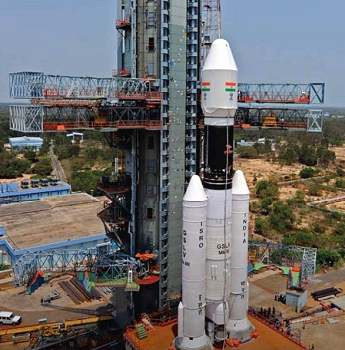
When it enters service, the 25 meter tall, three-segment, steel-case S-200 is expected to be the second largest active solid propellant motor in the world after the Ariane 5 EAP-E booster. NASA’s Space Launch System boosters will also surpass S-200 if and when they enter service. S-200 is 3.2 meters in diameter and is manufactured in a plant at Sriharikota.
The L-110 core stage is 17 meters long and four meters in diameter. It is powered for 200 seconds by two Vikas engines similar to the engines used on the second stage of PSLV and GSLV. On those stages Vikas burns for 150 seconds in a single-engine configuration.
The cryogenic third stage requires development of a new 20 tonne thrust CE-20 LH2/LOX engine, which is a pacing item for GSLV Mk 3. India’s less powerful Indigenous Cryogenic Engine failed during its first flight in on April 15, 2010 during the GSLV Mk 2 D3 mission. It finally succeeded during the GSLV Mk 2 D5 flight of January 5, 2014.
Also read: GSLV – Space Launch Report
Development
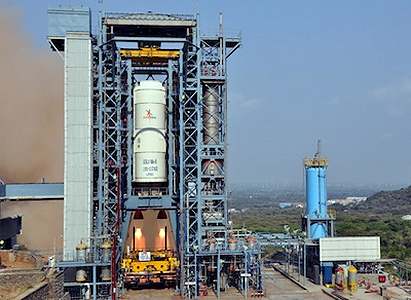
L-110 Core Stage Test at LPSC in 2010
An S-200 motor was test fired for 130 seconds on January 24, 2010 at Sriharikota. The motor produced a maximum thrust of 500 tonnes-force during the successful test. A second successful 130 second test was performed on September 4, 2011.
A static test of the L-110 core stage was performed March 6, 2010, at ISRO’s Liquid Propulsion Systems Center (LPSC) at Mahendragiri in Tamil Nadu. The test was aborted after 150 seconds of a planned 200 second burn. After an extended analysis, the test was repeated on September 8, 2010 and a full duration burn was achieved.
During January and February of 2012, ISRO fully assembled a pathfinder GSLV Mk3 vehicle at the Sriharikota Second Launch Pad complex. The vehicle was used to perform facility tests.
Suborbital Test Flight
A suborbital test flight without a live third stage is planned for 2014. Live first and second stages will boost a dummy third stage and a test payload on a suborbital trajectory.
Launch Sequence
T-0 seconds: S-200 ignition and liftoff
T+110 seconds: L110 ignition
T+130 seconds: S-200 burnout
T+149 seconds: S-200 jettison
T+253 seconds: Fairing jettison
T+310 seconds: L110 burnout/jettison
T+310 seconds: C-25 ignition
T+??? seconds: C-25 shutdown
T+??? seconds: C-25 second ignition
T+??? seconds: C-25 second shutdown (up to 580 seconds total C-25 burn time)
T+??? seconds: Payload separates into 180 x 36,000 km orbit
Vehicle Configurations
| LEO Payload (metric tons) 200 km x 45 deg | GTO Payload (metric tons) | Configuration | LIftoff Height (meters) | Liftoff Mass (metric tons) | |
| GSLV Mk 3 | 10 t | 4-5 t | 2 x S-200 Stg 1, L-110 Stg 2, C-25 Stg 3 | 42.4 m | 629 t |
Vehicle Components
| S-200 Boosters (Each) | L110 Stage 2 Core | C25 Stage 3 | Payload Fairing | |
| Diameter (m) | 3.2 m | 4 m | 4 m | 5 m |
| Length (m) | 25 m | 17 m | ~8 m | 5 m |
| Propellant Mass (tonnes) | 200 t | 110 t | 25 t | |
| Total Mass (tonnes) | ~235 t (est) | ~125 t (est) | ~30 t (est) | |
| Engine | S200 | 2xVikas 2 | CE-20 | |
| Engine Mfgr | ISRO | ISRO | ISRO | |
| Fuel | HTPB | UDMH | LH2 | |
| Oxidizer | – | N2O4 | LOX | |
| Thrust (SL tonnes) | 525 t | – | – | |
| Thrust (Vac tonnes) | 400 t (avg) | 140.72 t | 20 t | |
| ISP (SL sec) | (237 s) (est) | 240 s | – | |
| ISP (Vac sec) | (266 s) (est) | 281 s | ~450 s (est) | |
| Burn Time (sec) | 130 s | 200 s | 580 s | |
| No. Engines | 1 of 2 | 2 | 1 | 1 |
GSLV Mk 3 Flight Record
DATE VEHICLE ID PAYLOAD MASS(t) SITE ORBIT ----------------------------------------------------------------------- --/--/14 GSLV Test SR 2 SUB (1) ----------------------------------------------------------------------- (1) Suborbital test with dummy Stage 3. =======================================================================



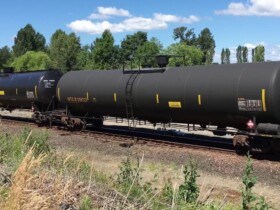










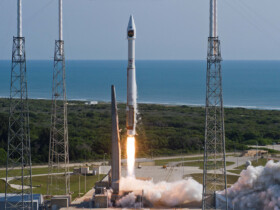
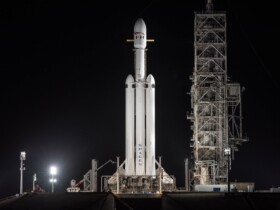
Got a Questions?
Find us on Socials or Contact us and we’ll get back to you as soon as possible.